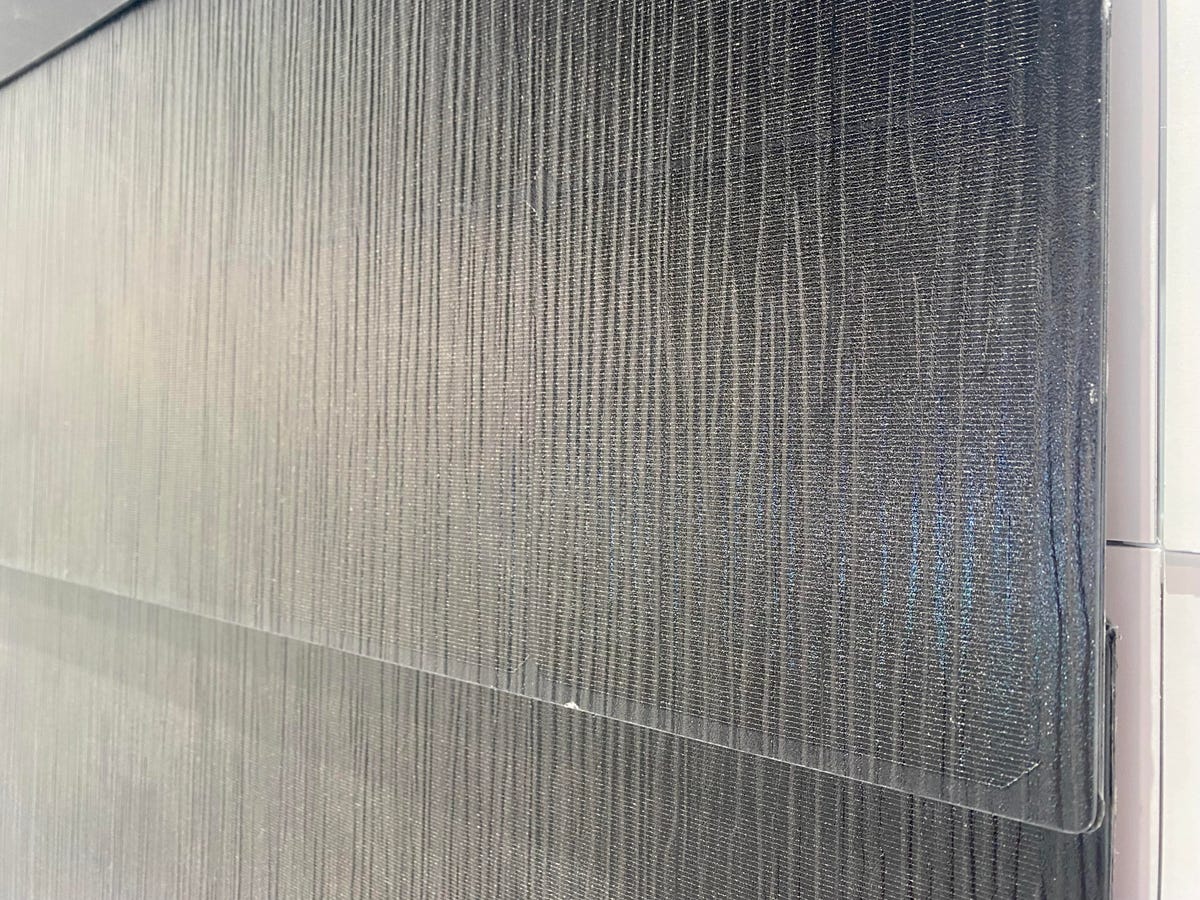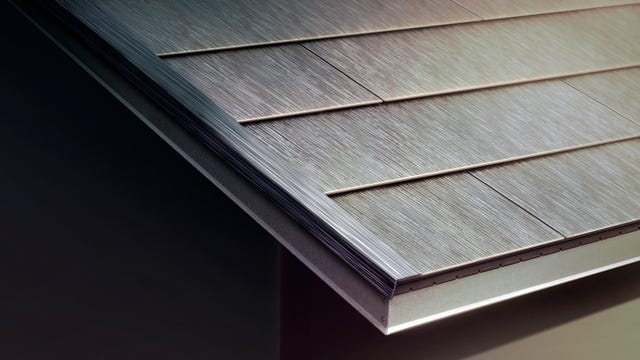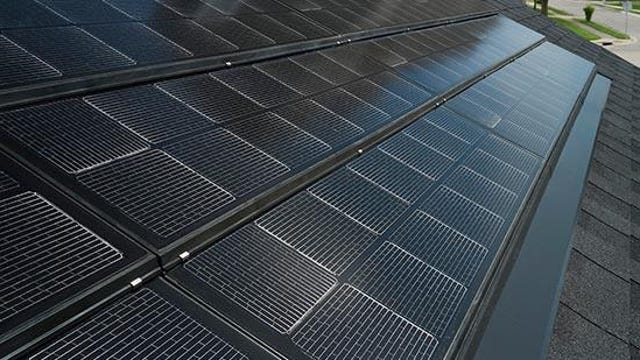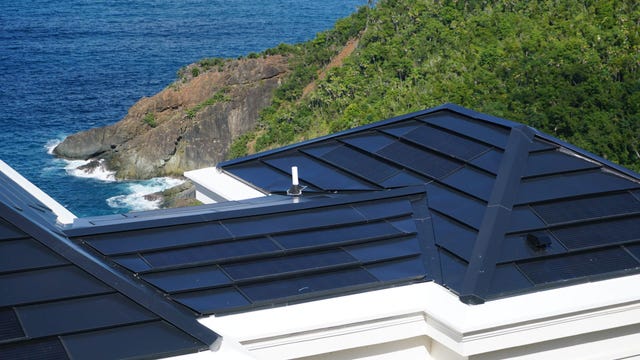The companies providing quotes may differ from those described in our independent reviews.
What is the best overall solar shingle?
Timberline Solar by GAF Energy is our favorite solar shingle, mainly for its great efficiency and warranties. But the race for first place is close. Even though they didn’t make the top spot, we still found Tesla Solar Roof and CertainTeed Solar to be solid options as well. Luma Solar scored lower than the rest, but we thought its ridiculously high wind rating at least warranted a mention.
Why choose a solar shingle over traditional solar panels? Solar panels can look bulky and detract from the beautiful aesthetic of your home. Solar shingles, on the other hand, integrate into your roof to create a more discreet solar system.
I’ve spent countless hours digging through solar shingle specs and speaking with industry experts to get a better understanding of how a solar roof works and what really matters for homeowners who might be interested in this type of solar setup. I created a scoring methodology (more on this below) based on my findings to pick out which solar shingles stand out among the pack. While the market for this type of solar solution is small, it’s still important to compare your options.
Here are our rankings for the best solar shingles.
Best solar shingles of 2024
Timberline Solar by GAF Energy takes the top spot with its excellent warranties and efficiency ratings. GAF Energy offers three limited warranties with its solar roof: a 25-year product warranty against leaks and manufacturer defects, a 15-year wind warranty and 25-year power output warranty. The power output warranty guarantees that your solar roof’s performance won’t dip any lower than 98% after one year and won’t decrease by any more than 0.55% per year for the next 24 years. These shingles come with the highest efficiency we’ve found (23%) and a solid wind rating of 130 mph. The only thing holding GAF Energy back is its lower wattage per square foot (14.3).
Tesla has a track record of making average but well-rounded solar products. The Tesla Solar Roof is no different. But it does come with the strongest solar roof warranties we’ve seen. Tesla offers three limited warranties for its Tesla Solar Roof. You’ll get a product warranty that protects your roof from manufacturer defects, a weatherization warranty that covers damage from wind and rain, and you’ll also get a power output warranty. The power output warranty guarantees that your solar roof’s performance won’t decrease to any less than 95% for the first five years and won’t decrease any more than 0.5% per year for the next 20 years. The Tesla Solar Roof has a lower wind rating of 110 mph and its shingle efficiency was not disclosed. We found Tesla Solar Roof’s wattage per square foot (15.3) to be average.
CertainTeed might not be as well-known as Tesla or GAF, but it’s still a good solar roof option for your home. You’ll get three limited warranties: a 25-year product warranty that protects you from manufacturer defects, a 25-year power output warranty and a much shorter 10-year wind warranty. The company guarantees that your solar performance won’t fall below 98% after one year, and won’t decrease by any more than 0.55% per year for the following 24 years. CertainTeed Solar’s shingle wind rating is 110 mph, which is lower than others on this list. This solar roof also comes with a fairly average efficiency rating (19.85%) and a slightly higher wattage per square foot (16.1).
Luma Solar scored much lower than our top three picks for the best solar shingles, but we thought it was worth including Luma Solar in the rankings for its standout wind rating. You’ll only get two warranties with a Luma Solar roof: a five-year product warranty and 25-year power output warranty. Luma’s power output warranty guarantees that your solar roof’s performance won’t have decreased by more than 80% after 25 years. As far as we know, the company doesn’t offer any kind of wind or weatherization warranty. But these shingles do come with an incredibly high 200+ mph wind rating, according to the product’s data sheet (PDF). Luma Solar’s efficiency rating (22.10%) and wattage per square foot (14.9) aren’t bad either.
What are solar shingles?
Solar shingles are a more niche way of installing solar panels on your roof. These shingles are essentially tiny solar panels designed to mimic traditional shingles and roofing materials. Instead of mounting solar panels on top of your roof, you can now have solar panels installed in your roof. Some solar shingles can be installed with an existing roof, while others might require an entire roof replacement.
“A solar roof is where you have the [photovoltaic] system integrated into the roof design,” Bianca Howard, director of the Building Energy Research Lab at Columbia University, told CNET. “So you’ve got the solar shingles, which are acting as the PV system, in terms of generating electricity, and also as a functional building material. So it’s got a dual purpose.”
Similar to normal rooftop solar panels, solar shingles absorb sunlight and use it to generate electricity to power your home. They tend to have lower efficiency and performance ratings than solar panels.
The main draw with solar shingles is aesthetics. Not everyone wants giant solar panels on their roof. Solar shingles are designed to blend in, which is why you might choose them over the solar panels even with the decreased energy efficiency and performance ratings.
“By incorporating them into the roof, people won’t immediately know that you’ve got PV on there, which is good from a design aesthetic,” Howard said.
Solar shingles are also made to be weather resistant, offering protection from high winds and water leaks. Most solar shingle manufacturers include some type of limited wind or weatherization warranty in your purchase.

Tesla’s Solar Roof shingles, like these seen at CES 2024, look a lot like regular rooftop shingles, particularly up close.
How to choose the best solar shingles for your home
There may only be a handful of solar roof manufacturers, but there are still a few things to pay extra attention to when looking at solar shingle products. If you have the luxury of having multiple solar roof options in your area, compare your options carefully.
Warranty
Most manufacturers offer a limited warranty package that comes in three parts: product warranty, wind/weatherization warranty and a power output/performance warranty. In terms of coverage length, the industry is all over the place. Some manufacturers offer great warranties, others not so much. Howard suggested what this means for your overall roof maintenance over time. Here are the warranty types you need to know.
Product warranty: This guarantees that your solar roof will be free from manufacturer defects in design and/or material. The best limited product warranty we’ve seen for solar roofs is 25 years.
Wind or weatherization warranty: Some solar shingle manufacturers also offer a wind warranty (sometimes referred to as a weatherization warranty). This warranty will typically cover your roof from any wind-related damage for at least 10 years. In some cases, this warranty will also cover water damage caused by leaks. The longest weatherization warranty we’ve seen is 25 years. However, most manufacturers will only cover wind damage for 10-15 years.
Power output or performance warranty: Every solar shingle manufacturer we’ve seen offers a power output (or performance) warranty. Just like normal solar panels, your solar shingles will see their production and efficiency drop as the years go by. A power output warranty is the manufacturer’s guarantee that your solar roof won’t drop below a specific production percentage within a certain amount of time. For example, Tesla Solar has a 25-year power output warranty. The company guarantees your solar roof’s production won’t drop below 95% of its original level five years after the initial installation. And after five years, your solar roof’s production won’t decrease by more than 0.5% per year for the next 20 years.
Wind rating
Every brand of solar shingle should come with a wind rating. Just like normal roof shingles, solar shingles can only withstand wind speeds up to a certain amount. A solar shingle’s wind rating tells you how high a wind speed your solar roof can withstand.
Solar shingles are designed to be weather resistant, with most solar shingles being able to withstand winds of at least 110 mph. We found the most common solar shingle wind rating to be about 130 mph. When deciding what solar solution is best for your home, ask yourself if you need that level of protection for where you’re living, said Howard.
If you live somewhere that is prone to extreme weather patterns, then a solar roof with a higher wind rating is likely a higher priority for you.
Efficiency
Just like traditional solar panels, each solar shingle has a maximum efficiency rating. This is the amount of sunlight that a solar shingle (and panel) is turning into electricity. The efficiency rating usually reflects the product’s performance during the best conditions possible. The higher the efficiency rating, the more electricity your roof will generate. The average solar shingle efficiency rating is around 19 to 20%. But it is lower than some of the most efficient solar panels on the market.
Keep in mind that since solar shingles are installed as part of your roof, they can’t be angled like solar panels, which can be adjusted for optimal sun exposure.
“You can’t put them on a particular axis, so you might not get maximum efficiency,” Howard said. “From what I’ve seen, the solar shingle efficiency is less than a typical solar panel. So from a performance point of view, you’re not getting more in terms of PV output and the amount of renewable energy you’re able to generate.”
Wattage per square foot
Every solar shingle comes with a wattage rating, which is the amount of power it can output under ideal conditions. Your solar roof’s wattage plays an important role in how much power you’ll be capable of generating. But what you’ll really want to look for is a shingle’s wattage per square foot. This measures how much power you have within a given amount of space.
The higher a solar shingle’s wattage per square foot, the less space it will take up on your roof. Depending on the cost of the specific shingle brand, this might save money because you’ll be installing fewer solar shingles to meet your energy needs.
“What you’d want to know is the equivalent amount per square foot that you can get,” said Howard. “Because if you have a higher wattage per square foot, then that’s a better shingle in terms of power output.”
Are solar shingles better than solar panels?
Which are better, solar shingles or solar panels? It’s honestly up to you and your personal preferences. Solar shingles are a niche technology with very limited availability. So it’s tricky to compare them directly against traditional rooftop solar panels. Both have similarities, but they are still two different types of PV systems. Think of solar shingles as an alternative way to install solar on your roof.
“Solar shingles, as another option for building integrated photovoltaics, is a good thing,” said Howard. “It’s a personal choice about your values of design versus performance. I wouldn’t want to put them against each other and say that one is better than the other, in a holistic sense.”
There are certain situations where solar panels might make more sense for you than solar shingles, and vice versa. If you need to replace your roof before installing solar, prefer a more subtle approach to solar and there’s a solar roof installer in your area, then solar shingles might be a good choice. Solar shingles might be more likely to be accepted by your homeowners association too. However, some states have laws in place that prevent HOAs from banning solar panels.
If you don’t mind the look of solar panels on your roof and you’re not replacing your roof anyway, traditional rooftop solar panels might be a better fit. Just keep in mind that solar is a personal choice, and the battle between solar panels and solar shingles really just comes down to personal preference and budget.
Pros and cons of solar shingles
Pros:
- A convenient option if you need a roof replacement to install solar panels.
- Weather-resistant.
- A more discreet way to install solar on your home.
- Modern and sleek roof design.
Cons:
- Limited availability.
- Can be less efficient than some solar panels.
- Can’t be angled.
- Will likely cost more than solar panels.
How much do solar shingles cost?
Solar shingles are a niche product and are not nearly as widely installed (or available) as regular solar panels. This makes finding reliable pricing data tricky. If you purchase solar shingles, you’re also likely paying for an entire roof replacement.
While pricing data for most solar shingle manufacturers is unavailable, we can use Tesla Solar Roof estimates from Tesla’s online estimator to at least get an idea of how much a Tesla Solar Roof would cost. The general consensus is that a solar roof costs more than just installing solar panels. We found this to at least be true for the Tesla Solar Roof. And it’s probably not your best option if you’re looking for cheap solar.
Tesla estimated a cost of $168,400 for a 12.5kW solar roof system and a Tesla Powerwall battery for a home in Dallas. The Tesla estimated cost of a regular 12kW solar panel system and a Powerwall at the same location is $26,966.
Pricing for the Tesla Solar Roof is an estimate based on your address, average electric bill and the square footage of your roof. Tesla also requires the purchase of at least one of its batteries, the Tesla Powerwall, per solar roof. A Tesla Powerwall will cost you an additional $9,500 or more.
But these prices should be taken with a grain of salt. Just like with solar panels, everyone’s solar roof estimates are going to vary depending on your energy needs, location and other factors. The best way to get an accurate price estimate for any solar shingle or panel system is to talk to an installer in your area. If you have multiple installers in your area, make sure to compare prices.
How we evaluated the best solar shingles
CNET has not performed any form of hands-on testing with these products. Solar shingles are part of a complex PV system that is integrated into the roof of a house or structure. This makes hand-on testing difficult. Instead, we took the most common solar shingle brands on the market, and made comparisons between them to find the best option. It’s also important to note the limited availability of solar roof products, making choices for this list limited as well. Here’s how we scored the best solar shingles.
First, we determined what categories we would use to evaluate each solar shingle. Each category was given a weight reflecting how important we felt it was to the average consumer. After examining data provided by manufacturers and speaking with subject matter experts (who did not influence the choices that were made for this list), these were the categories we chose to evaluate each solar shingle brand on.
- Product warranty: 20%
- Wind/weatherization warranty: 15%
- Power output/performance warranty: 20%
- Wind rating: 10%
- Shingle efficiency: 15%
- Shingle wattage per square foot: 20%
We looked at five of the most popular solar shingle providers on the market, collected the data for each category and compared the numbers. Each category (for every solar shingle) was given a tier-style rating to evaluate which aspects of each solar shingle were above average (among our list), just average or below average.
Solar shingle FAQs
How long do solar shingles last?
The longevity of your solar roof depends on the manufacturer and the installer. But most solar roofs are designed to last between 20 and 30 years. This is comparable with traditional solar panels, which typically last 25 years or more. You should also check solar shingle warranties. If your solar roof is warranted for 25 years, that’s a good sign. Most solar shingle product warranties that we found lasted at least 25 years. However, there were some that only covered five or 10 years.
Can solar shingles cause leaks?
Yes, if not installed properly. You’ll want to select an installer that has a proven track record of installing solar on the type of home you’re in and the type of roof you have. If the job is done right, you shouldn’t have to worry about leaks. Some solar shingle manufacturers include water damage in their product or weatherization warranty. GAF Energy in particular promises fewer leaks than others.
How many solar shingles do you need?
You’ll need as many solar shingles as it takes to meet your home’s energy needs. Your installer will help conduct an energy audit to determine how many solar shingles you’ll need. Keep in mind that not every solar shingle on the market has the same wattage (or power output), and traditional solar panels offer a significantly higher wattage than an individual solar shingle.






